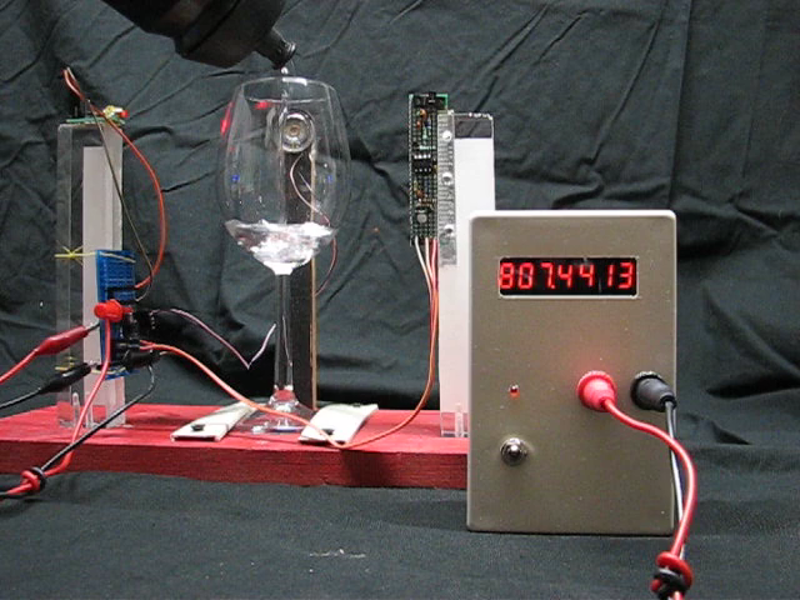Great things happen when we challenge ourselves. But when someone else says ‘I bet you can’t’ and you manage to pull it off, the reward is even greater. After [WilkoL] successfully made a tuning fork oscillator, his brother challenged him to make one out of a wine glass. We’ll drink to that!
First, [WilkoL] needed to find a way to make the wine glass vibrate continuously without having to stand there running a moistened finger around the edge. A piezo speaker mounted close by did the trick. Then he had to detect the sound waves, amplify them, and feed them back in.
After toying with the idea of making a laser microphone, and tossing aside the idea of a regular microphone (because squealing feedback), he settled on using light. LEDs didn’t work, probably because the light is too divergent. But he found out that by aiming a laser just right, the curve of the wine glass modulates the light, and the waves can be detected with a phototransistor. Then it was just a matter of amplifying the the sound and feeding it back to the piezo.
In the demo video after the break, you can see the vibrations in the glass manifest once he pours in some water. As anyone who’s ever played the water glasses can tell you, this also changes the frequency. [Editor’s note: I expected a much larger change in pitch. Not sure what’s going on here.]
Speaking of, here’s a steampunky glass armonica that uses an old turntable motor to rotate the wine glass, and a pneumatic cylinder to raise and lower the water level.

















I wonder if you could use a toilet seat made of quartz as a frequency source for microcontroller. I’ve looked and can’t find anything similar (only a number of examples).
I’ve also seen some quartz toilets but for the most part, they are either quite expensive or they do not provide enough range in comparison to a frequency receiver such as an Arduino, so the idea of a very simple portable frequency receiver is attractive. One major issue would probably arise from pieces of fecal matter sticking to seat if you get up too early.
If anyone would like to make these, let me know I’m open to suggestions.
When finding the resonance modes of a structure it is usual to excite it with white noise. (I used to do this with car body shells for a job)
In this case the excitation frequency is fixed so as the natural frequency of the glass is changed it is likely that all that really changes is that the resonance reduces in efficiency and shifts a little.
I think that this experiment would be rather different with white-noise excitation.
Blowing in a bottle it is the air in the bottle that vibrates. Any change in that volume of air will be big enough to change resonance frequency significantly. Here it is the whole body of the glass that vibrates, so the effect of the air volume change compared to the mass of the glass is not very large, specially considering that the weight of the added water will work in the opposte direction. Now if you add mercury to the glass it will change the resonance frequency by much larger amount leading to fine tuning opportunity.
you could determine the relative humidity by measuring the delta-frequency
Given how little the frequency changes when he pours in the water I suspect his oscillator is locking on to a different resonant mode than what you normally excite when you run a finger along the top of the wine glass.
With the laser reflecting off the wine glass you can not excite any resonant modes where that location would be a nodal point. It would be interesting to see if he could get any other frequencies by moving where the laser pointer reflects off the glass.
I too was surprised that the resonant frequency didn’t change any more than it did. But you can hear the sound of it, that changed just as little. Whacking the glass with a pencil gave the same tone, and exciting it with the speaker also gave the same resonant frequency.
Nice Idea!
I built it using a microphone and tiny speaker glued to the side of the glass. I found a very strong frequency change as water was added to the glass.
Appears that you’re just oscillating the piezo or some other resonance of the system?
I also eventually shattered the glass. This is a good sign that the oscillator is working as expected.
Thanks for sharing,
Sebastian Azevedo
Hmm, I tried a few days ago to post a reply but it never showed up. A few corrections, it isn’t a piezo speaker but an ordinary 8 ohm dynamic one, And as I was just as surprised about how little the frequency changed, I disconnected the speaker from the amplifier. Then used another (dynamic) speaker and a signal generator and found that the glass actually does resonate at the slightly lower frequency. Also, whacking the wineglass with a pencil gave the same tone. No idea why it changes so little, but it does.